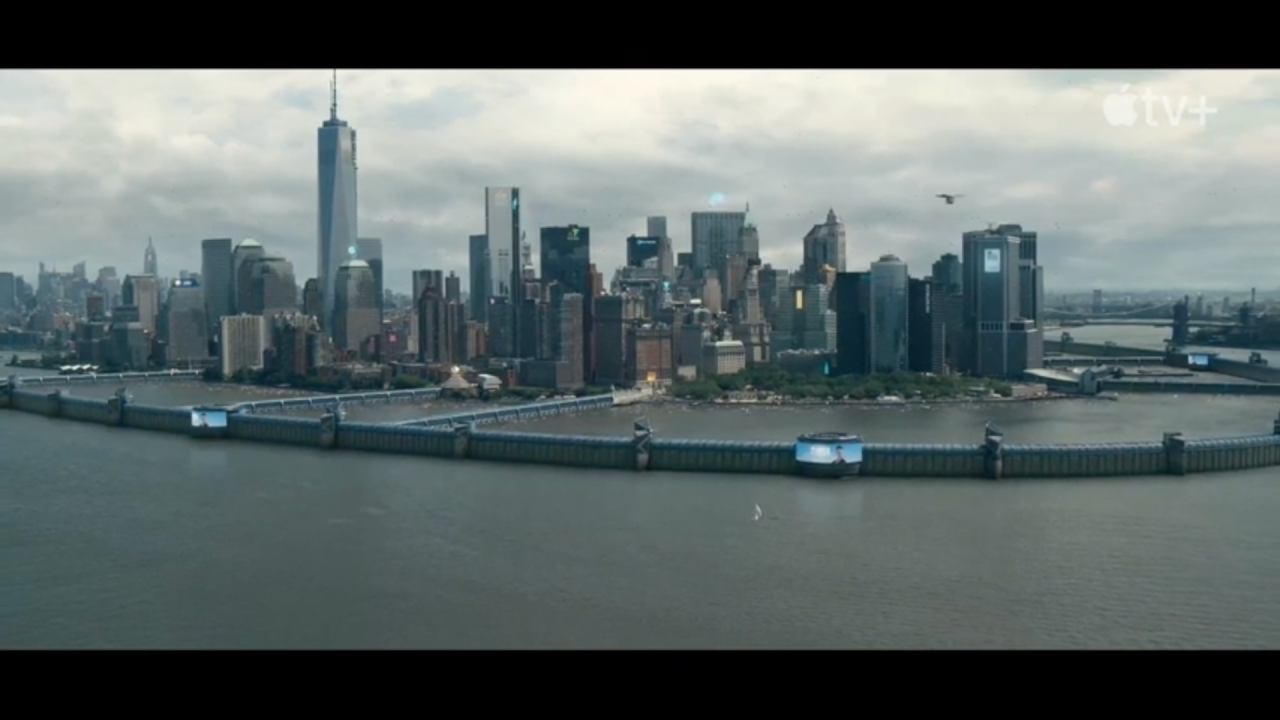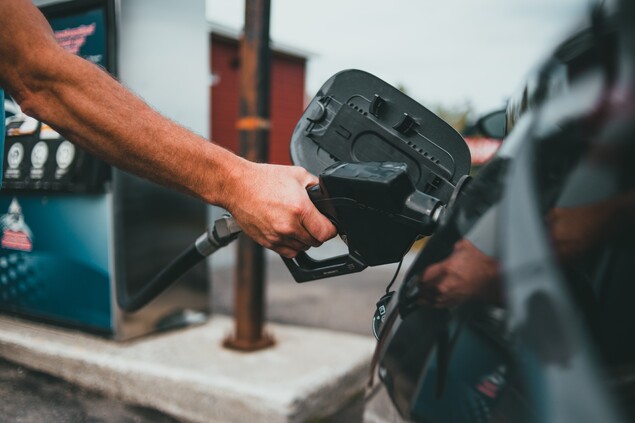 NY with dikes. Image from Extrapolations. ©️ Apple TV
NY with dikes. Image from Extrapolations. ©️ Apple TV
Why we will fail at climate change
TL,DR: Our society is locked into a high-energy consumption lifestyle that few are willing to abandon. Although efforts are being made to reduce carbon emissions through renewable energy sources and electric vehicles, these reductions will eventually plateau. We must prepare to adapt to a planet with an altered climate.
One thing I have learned after tutoring many cohorts of Sustainable Infrastructure and Clean Energy Technologies at MIT Professional Education, is that you really need to look at the big numbers.
And when you look at the Carbon emissions, the numbers are devastating. Carbon (or equivalent green-house gases) is a stock variable, meaning it accumulates in the atmosphere and it will take a long time (hundreds to thousands years depending on the gas) to be naturally reabsorbed to the average levels. So what is important is how much is already in the atmosphere (the cumulative Carbon budget).
However, we are still focusing on how much are still emitting per year (over 50 Gton in 2022). And that number has been exponentially growing even since the time we acknowledged that it will be a problem (as early as 1896 by Arrhenius but seriously from the 1950s).

There has been recently good news on this, since, according to this study, the yearly emissions may have been peaked. That means that the Carbon emissions per year will be decreasing from that point. (Not that the atmospheric Carbon quantity will decrease, only that it will continue stocking up but a slower rate)
Even though this is good news, it is bittersweet. To achieve the critical 1.5 or 2-degree Celsius target (considered safe, yet still with adverse consequences), we need to reduce our emissions by approximately 6-8% per year, every year, for the next 50 years, so the total stock of CO2 (budget) do not pass a certain level (1750GtCO2eq).

Just to put this number in context, we, as humans, were only able to do that in 2020 (-8.8%), the year of the pandemic thanks to have a brutal life and economy restrictions, such as not travelling, being forced to be at home, closing factories or stopping construction. (study: Liu et al.)
That surfaces the cruel reality: we would need a pandemic every single year for next 50 years to get to the objective.
Thanks to the Kaya Identity, we can understand where the Carbon is actually coming from and what we can expect in future. Understanding the Kaya Identity not only sheds light on the sources of emissions but also helps us see how our daily choices and broader societal behaviours amplify these effects. This brings us to an important aspect—our lifestyles. This is the Identity formulation:
Developed by the Japanese economist Yoichi Kaya in 1997
Thus, Green-house emissions are directly proportional to Population, GDP per Capita, Energy Intensity (how much energy do we need) and Carbon Intensity (how much Carbon our energy consumption emits). How these components have evolved in the last decades is in the image below:

Extrapolating the individual components of the Kaya Identity to the future give a sense of why we will fail at climate change.
Let´s analyse what would be reasonable to happen for each factor:
- Population. It will likely continue to grow, or at best, remain constant as some countries experience peak or declining populations (like China or many occidental countries)
- GDP Per capita. Is in human nature to life better and be wealthier. All countries continue pursuing to grow it. Having more economic resources imply more energy consumption, as the image below shows. People will buy bigger cars, travel more and farther, consume more products from far away, etc

- Energy Intensity (Energy/GDP). This is related to performance being a design and engineering topic. The Energy intensity trend is to decrease, as long we design systems that are more efficient, such as cities with more public transportation, hybrid cars or swapping high speed train for planes. However, there is a hard limit to the performance dictated by thermodynamics and the technological lock-ins, which we will discuss later.
- Carbon Intensity (Emissions/Energy). Here is were all the efforts are focus now. Phasing out coal plants and develop renewables reduces Carbon Intensity, as well the use of Electric Vehicles instead of oil. There have been a lot of improvements and the trend will continue decreasing.
All of this, considering there is no big catastrophic events that can alter the reasonable trend such as a world war, a (harder) pandemic or an asteroid.
So we observe that the two first factors are growing emissions but the two latter are decreasing. The question is if the two latest can compensate for the two first. Clearly that not happened in the last 40 years.
About Energy Intensity, we have a big problem of technological and cultural lock-in, that is, the more a society adopts a certain behaviour, the more unlikely users are to switch. Unfortunately, the high-energy occidental living model is what every society in the world pursues as a successful and wealthy life. What make us happy turns out to be owning and getting traffic-jammed on powerful cars, wearing almost single-use clothes, travelling far for vacations, consuming beef wrapped on plastics that we rapidly discard, living in detached houses (with pool if possible), etc… As long as the highly populated developing countries grow and copy our errors (as they are doing), the Energy Intensity will not quick decrease although we try our best in improving the efficiency of engineering systems. And everyone have the absolutely right to live better, although probably following a wrong path.
We have a big problem of technological and cultural lock-in.
Respect to Carbon Intensity, there are improvements every day as long as renewable energy is installed. However, in my opinion, the reduction will eventually plateau. The current reduction is mainly coming from the electricity production sector (that represent about one third of the emissions) and it is the easiest to decarbonise. The emissions are concentrated in some few agents (producers of electricity) and we have technology available (solar PV, Wind turbines and soon Batteries) that are cheaper than the Carbon options (coal and almost gas). But, what will happen with the other two thirds of the problem (industry and transportation) were we do not even have a competitive solution (soon EV) or even a zero-carbon technology solution at all? There are sectors very difficult to decarbonise such as aviation or steel and cement production (study: NREL):

The Carbon Intensity reduction will eventually plateau.
Moreover, since there is a silent war in place, between the old status companies (oil, coal, gas) who subtly use all their huge resources and power to pull the strings behind the scenes in their favor, with disinformation campaigns, targeted lobby and adding block-roads in any possible way. Funny that many of these companies shares are also in our retirement portfolios, so we are indirectly supporting it too.
So, what we can expect?
The most reasonable path, the one we are in, is that we will probably end up the century far over 2ºC, close to, or even over 3ºC.
The hope is that the predicted effects are not as catastrophic as expected, or they happen at a slow pace due to the planetary inertia. If the climate change effects happen slow (in decades or centuries) humans can adapt.
At the end of the day, life in the earth has existed at average temperatures even +15ºC higher than today (only caveat is that there were not humans at that time) (study: Haywood, AM et al.).

We will live in a different world, with some areas not longer habitable inundated by water (such as Miami, Pacific South East, Delta del Ebro or Venice), or too-high temperatures (Middle East, Central Africa). Others may be more liveable like the northern regions in Europe. More frequent extreme climatic events may rank up as a reason for death (due to more diseases, extreme heat or cold waves, hurricanes, floods) or drive food scarcity. Some leisure activities like skiing may become ultra exclusive or just disappear forever.
Thus, if changes are not very fast, our technology may adapt, for instance with more AC, reclaiming land from the sea, multibillion dikes or artificial snow. We can also dream of science fiction technology breakthroughs that luckily solve the problem such as fusion nuclear, planetary geo-engineering or a friendly and patronising AI.
However, if changes occur rapidly, we will struggle to adapt, with persistent crisis, spiralling inflation, scarcity of (many?) foods and water, conflicts, migrations (climate refugees?) or even climatic wars?
Are you interested in Sustainability? Follow me or drop a comment below👇 for more Sustainability insights. I also strongly recommend the MIT professional certificates (where I am Teacher Assistant and we learn about what I shared here).





